Effects Pedals
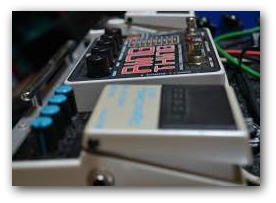
If you know what guitar and amplifier you want to use, effects pedals (also called stomp boxes) will most likely be your next stept!.. Why?
To ad flavor to your sound. Make it spicy or sweet.. whatever you like!
In the early days musicians discovered that amps will start to distort when they cranked them up. Amps where not made for that but it just happened!
Somehow guitarist liked this sounds. It changed the way amps where build and it gave life to a new thing: pedals!
There are many different stomp boxes for sale. Some boutiques pedals can be really expensive, but you can buy cheap effects pedals that are good also!
good to know
If you use effects pedals it is best to place them in the right order.
Another thing that is good to know is how pedals effects your loss of tone
effects pedals are used for:
- gain
- modulation
- volume, feedback, sustain and compression
- delay/echo and reverb
- filter/equalizing
- pitch
- noisegate and buffer
gain
Gain pedals are used a lot by guitarists all over the world . There are three types of gain pedals:
modulation
Modulation pedals are used to change the signal and create a different (crazy ) sound. Pedals used for modulation are:
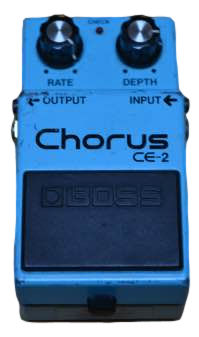 Boss CE-2
Boss CE-2- chorus
- tremolo
- vibrato
- flanger
- phase shifter
- leslie/rotating speaker
- ring modulator
volume, feedback, sustain and compression
Of course there is a a volume knob on the guitar and some guitarists are really good in using it while playing guitar (Jeff Beck for example). But many guitarists prefer a volume pedal to change volume so they keep there hands free to play guitar.
In guitar terms " feedback" is a sound loop between the pick ups and the speakers. Jimi Hendrix was a master in using feedback in his sound. It is not always easy to control the feedback and you have to play loud or use a lot of gain to get it.
Feedback pedals will give you that control under your feet and make it possible to get it with low volume to!
Most of them will also give you more sustain. Sustain is the time that you will hear your tone coming through your speaker. It is very nice if that sustain is long!
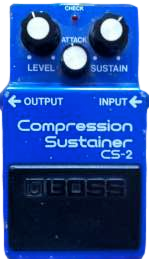 Boss CS-2
Boss CS-2There are special sustain pedals most of them in combination with a compressor. Boss CS-2 is one of them. A compressor is used to control the dynamic range of a signal. The loudest peaks of your guitar signal will be reduced. The softer parts are turned up.
The compressor gives more sustain to a clean tone. Distorted tones will be smoother with more sustain
delay/echo and reverb
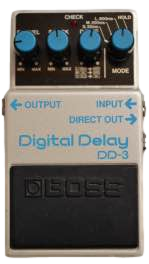 Boss DD-3
Boss DD-3An amplifier without any effects has a dry sound. This can be great for some strong riffs. But many guitar players prefer a little space in their sound. Like a choir in a church! Delay and reverb deliver space to your tone!
pitch
On a guitar you can play beautiful chords, but somehow guitarists wanted more!
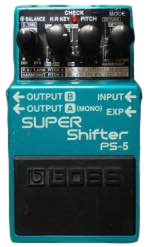 Boss Super Shifter PS-5
Boss Super Shifter PS-5They wanted more harmonics and more possibilities. Pitch effects were the solution:
- Octavers
- Pitch Shifter (Harmonizer)
- Pitch Bend
- Doubling Effects
noise gate and buffer
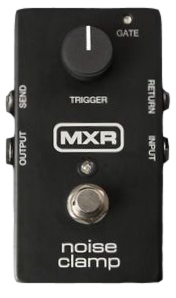 MXR Noise Clamp
MXR Noise ClampEffects pedals can create noise. The more gain you use, the more hissing you will hear. When you are using single coils there can be irritating buzz in your signal. Noise gates are there to eliminate the unwanted noise
Noise gates will silence your tone as soon as you stop playing. It works with a threshold. It takes some puzzling before it is set right though! You don't want your nice feedback to be destroyed by your noise gate.
There are lots of guitarists (like me) who don't use a noise gate. Good quality cables, noiseless pickups and switching of your overdrive or distortion in quiet parts wil work also.
filter/equalizing
Filters an equalizers are used to modify and change your tone. Effects used for filtering are:
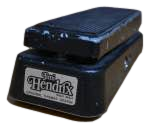 Jimi Hendrix Wah by JimDunlop
Jimi Hendrix Wah by JimDunlop- Equalizer
- Wah-wah
- Envelope Filter/Auto-Wah
- Talk Box
Place effects pedals in the right order
There are some do's and dont's in placing effects pedals in your pedal chain, but feel free to experiment with it, cause nothing is really wrong!
Here is a common way of placing them:
- Tuner (with buffer). Some old fuzzes with germanium transistors don't react very well to a buffer. Better to put the tuner after it then.
- Compressor
- Wah pedals
- Gain pedals
- Modulation pedals
- Delay
- Reverb
If you use a noise gate its better not to place it after a delay, cause it will affect the repeats.
Boost pedals can be placed before or after gain pedals. If you place them before the gain pedals you will get more distortion. Placed after the gain pedal it will boost your volume.
effects pedals and loss of tone
If you use pedals you will lose some high end of your guitar tone. Main reason is the cable length! You need a cable from guitar to effect, between effects and from effects back to your amp. Long cables suck tone! This it noticeable with cables longer than 18 ft (5,5 meters).
Pedals with a buffer circuit where the solution. The buffer will keep your signal in shape. So there is no tone loss with long cables.
Down side to some buffers are that they do affect your tone.
So the next step is true bypass pedals. True by pass will take away the signal from the circuit when the pedal is off. That is a good thing, but there is still a problem. You will lose high end because of cable length!
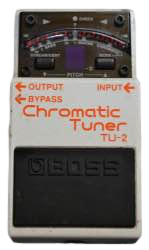 Boss TU-2
Boss TU-2That is the reason why it is still a good idea to use a buffer in your effect chain. Personally I use a Boss TU-2 tuner placed first in my chain. Like all Boss pedals it has a buffered circuit, so after the tuner my signal is consistent. That works for me.
THUMBS UP IF YOU LIKE THIS SITE!